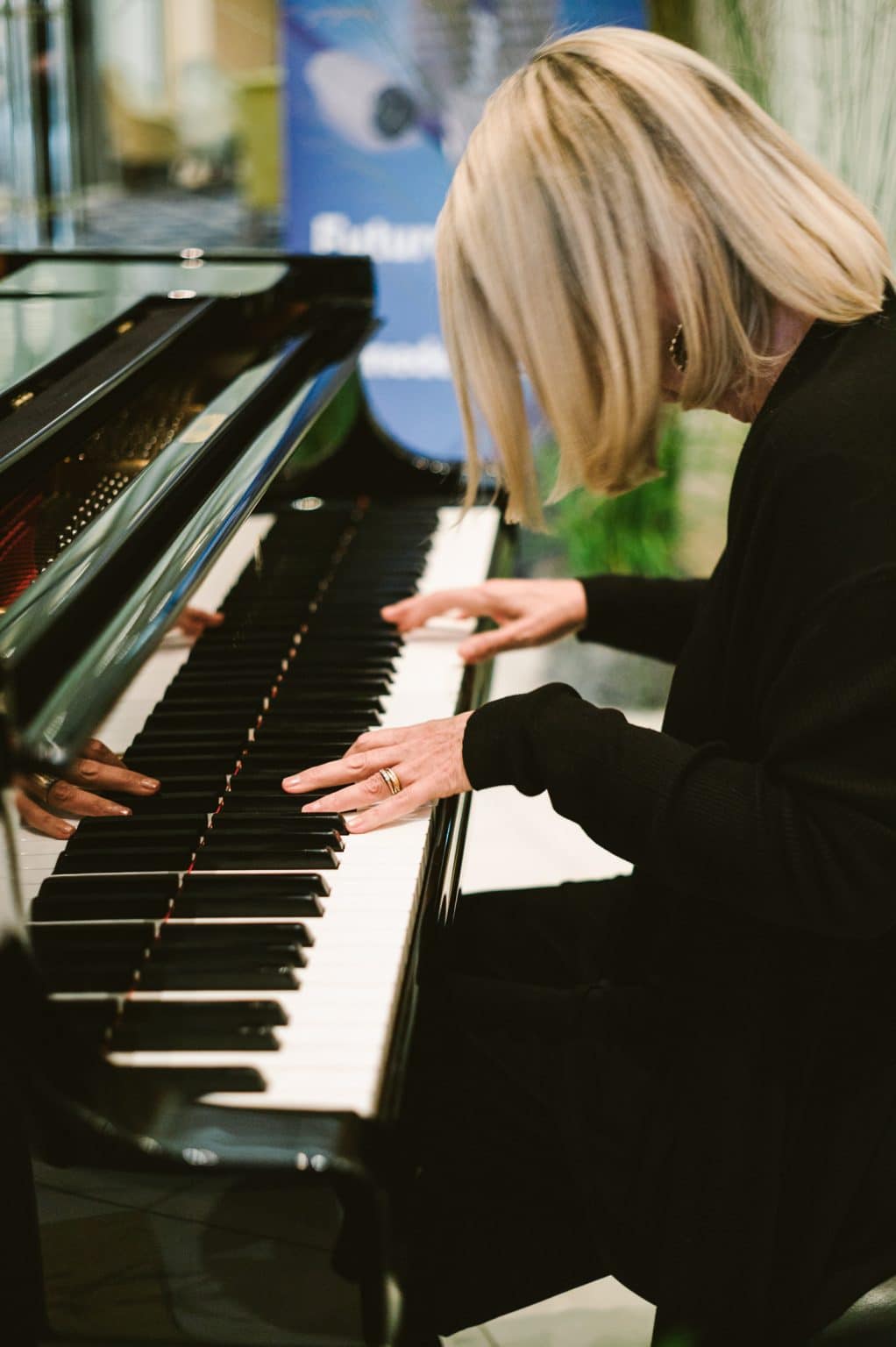Give Me the Night.
In 1982 Dale Cinski was twelve-years old and obsessed with the guitar. He idolized George Benson and tried to imitate his style by listening to and playing along with George’s records. With the help of his cousin, drummer Spider Rondinelli, Dale copped tickets to a Benson concert at the Syria Mosque in Pittsburgh. He wrangled his way backstage and told George how much he loved playing the Ibanez GB-10 (Benson’s signature guitar). Two years later, Dale–exhibiting an unusual amount of pluck for a teen guitarist—showed up at George’s hotel and played a song called “Being With You” from Benson’s In Your Eyes album.
“Man,” said George to Dale, “You’ve got some chops.”
Boom. George Benson became Dale Cinski’s mentor.
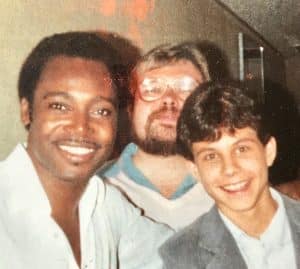
Uncle George is now seventy-five. Dale is forty-eight. They visit each other at George’s home in Paradise Valley, Arizona, hang out whenever George is in Pittsburgh, and stay in touch on the phone. The two of them have played a gazillion notes over the last three decades—George in stadiums and the world’s best concert halls, Dale in decidedly more modest venues.
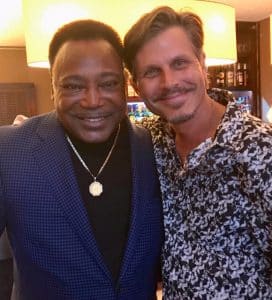
Dale—married to my sister, Badass Randy—is a welcome addition to our family of rhythm section players. John (my husband), Randy, Dale, and I arrived in Paris on Sunday to attend George’s concert, cancelled at the last minute due to George’s gorge irritée (sore throat). Oh, the perils and responsibilities of fame. Like most musicians, if I get sick, I either soldier through the gig or call a sub and lose a few hundred bucks. No one throws a fit. When George cancels, he disappoints throngs of fans, loses tens of thousands of dollars, and causes his entire touring company to fall into panic mode. That’s a lot of pressure for one aging guitar player.
The older I get, the more I respect the tenacity required to balance prominence with virtuosity. George Benson is clearly an artist dedicated to the craft of making music, but he’s also a stalwart celebrity, keen on maintaining his judiciously-groomed notoriety. George has been walking the celebrity tightrope for decades and, aside from the current gorge irritée, has remained ready, steady, and in the game. I can’t wait to meet him.
I truly admire musicians—famous or not—with careers that span decades. As my dad likes to point out: “It’s easy to have a hit; it’s much more difficult to have a career.”
Not that there’s anything wrong with a hit.
We make our own fun in Paris while we wait for George’s voice to return. We know we won’t get to hear a concert, but at least—thanks to Dale—we’ll get to hang out with him. Julia, my photographer daughter, joins us so she can spend more time with Randy and Dale. The five of us visit the steamy grounds of the Louvre, wander through the scorched Jardin des Tuileries, gaze at the Monet water lily panels at Musée de l’Orangerie, and spend two hundred Euros on falafel at an upscale Lebanese restaurant that caters to the rare, starving vegan stumbling through city lanes in search of sustenance. To escape the extreme heat, we book a Canal Saint-Martin river rat cruise and find ourselves—after passing through a dozen antiquated but functional locks—floating underneath city streets with shards of daylight cutting through circular overhead windows. It’s the coolest I’ve been in a month and despite the gloom, doom, and musty-dusty-rusty smell of it all, I’m happy.

Two days after the missed concert, George calls Dale and schedules a cocktail-party meet and greet for all of us. Julia opts out so she can go search for rumored Banksy paintings recently sighted on Paris streets. We jump in an Uber and arrive at the hotel where the band is staying. George’s voice has returned. He’s thrilled to see Dale again, and happy to talk to all of us about music and life; the gig he played with John and Lionel Hampton at Carnegie Hall back in the eighties; the Crawford Grill and his Pittsburgh roots; about his dear mother, a nurse, who once cared for my father in a Pittsburgh hospital; about the music business in Germany.
After a low-key, but inspirational hour with him we’re joined by a couple of George’s rhythm section players, most notably bassist Stanley Banks, who has held down the low end of Benson’s sound for decades. Stanley has recently lost over 100 pounds by eating raw vegan food, so our conversation veers back and forth between bass lines and recipes for almond milk smoothies.
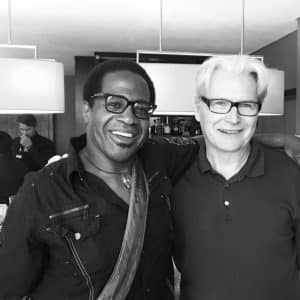
As the evening stretches out, two teenage gypsy-guitar players show up to play for George, each of them out Django-ing the other. George cheers them on, offers a few tips, and suggests alternate changes to the tune. Then George plays for the kids. What a thing—a legendary guitarist giving a master class in a Paris bar.
“This is what he does,” Dale says to me. “He helps young musicians. These kids are like me, thirty five years ago. They’re never going to forget this night.”
I turn to George and express my admiration and he says: “Hey baby, these kids are the future of music. It’s my duty to guide them.”
Go, George.
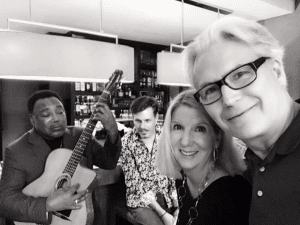
The hotel lounge is now full of fans and friends, clustered around Uncle George and hanging on every note. It’s a scene. At my request (and with Stanley’s urging), he plays his version of “People,” even though other guests in the bar—unaware there’s a superstar playing a private concert for anyone who wants to listen—complain that they can’t hear the television broadcast of the World Cup soccer match.
“The music is too loud!” says one of them.
“You’re blocking the television!” says another.
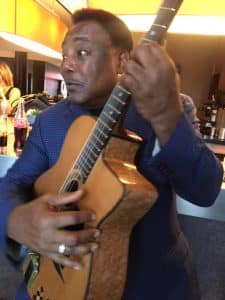
George graciously picks up the bar tab and we go to dinner with his entourage, including the Benson management team, the Gypsy-guitar brothers, a nightclub promoter, and two lovely—but slightly desperate—young women who appear to be from an escort agency. We dine at a Japanese places (close to the Avenue des Champs-Élysées) where everyone sits around a grill and a ninja chef throws meat and fish in the air before chopping it with the French version of the Ginsu knife.
After dinner, the promoter invites us to a trendy nightclub around the corner. It’s one of those velvet rope places with beautiful, thin, Europeans in fifty shades of anthracite. They slouch, lurk, and look bored, chic, and perfect. We, on the other hand, are a mixed bag of fashion do-s and don’t-s. George, our designated celebrity, looks sleek in his cobalt-blue silk jacket and gold medallion, and his team fits right in with their hip gangsta-rapper outfits (one of them has a pirate scarf on his head). As one might expect, the escort girls are decked out in short skirts and high heels. The Gypsy-guitar teenagers look good because they are sixteen, wearing black, and have faces that resemble freshly peeled eggs. But the chic quotient goes downhill fast when it comes to the rest of us. Randy and I, in our misguided attempt to make a Boho fashion statement, resemble Great Aunt Edna and her spinster sister Gertie, headed to a hoe-down. Dale’s shirt is floral and foppish and suits him in a Jimmy Buffet meets Sting kind of way. John, in what may be the French fashion faux-pas of the decade, is wearing a Lands End golf shirt and chinos.
Because we are with George, the buff bouncer lifts the velvet rope and lets us cross the threshold. I can’t help but notice that George’s musicians have not joined us for this part of the evening’s festivities. Maybe that’s part of being an A-list sideman. You get to eat a room-service club sandwich and go to bed at a respectable hour.
“I’m trying to channel Rihanna but it’s not working,” I say, worrying whether or not I have sake stains on my dress. “I thought tonight would be a simple bar hang, not a trip to Paris’s most exclusive nightclub.”
“This is so wrong,” says John. “Look at me. I haven’t even mastered the French tuck. I am the middle-aged dad poster guy.”
“Not true, brother,” says Dale. “At this time next week all of Paris will be wearing those Lands End golf shirts. You’ll start a trend. Bass player chic.”
“Plus,” says Randy. “You have fabulous hair.”
“Karl Lagerfeld would cringe,” I say.
“Who’s he?” says John.
With the judgmental eyes of the Paris fashion police upon us, we follow the club promoter and the escort girls through the heavy padded doors, down a padded staircase and into a padded private VIP area best described as a padded velvet womb. It’s the second time today I’ve found myself underneath Paris—once on water, this time on shaky ground.
The club throbs with techno music, the kind of stuff most musicians hate, but here we are, in the VIP section, with strapping male-waiters waving sparklers and pouring huge tumblers of champagne from magnums of Dom Perignon. I am suddenly extremely tired. I should have stayed back at the hotel with Stanley. He’s probably eating a chopped salad and watching CNN. The blaring music rattles my teeth. We have to shout in each other’s ears.
“More bass in the place!” yells John.
“I am thirty years too old and thirty pounds too heavy for this joint,” I say.
“Right!” says John. I like to think he can’t hear me. “This is the kind of place I have spent my life avoiding,” he shouts.
The escort girls start to dance for us. Enough. I join them. I might be sixty and dressed like I stepped out of a 1996 Talbot’s catalog, but I can jiggle my trunk junk with the best of them, especially after consuming a bucket of sake and three-hundred bucks worth of champagne. As my 102-year-old Piano-Girl friend Emily Remington recently said: “I might be old, but I’m not cold.” Screw the sunset and wisdom of age and the Golden Girls and dignity and all that—I’m dancing. The walls are padded and so am I. Randy gets up and joins me. We do the hoochie-koochie dance with our two Parisian escorts. Hoe-down, throw down. John makes a video and sends it to Julia, who, in a classic case of opposite world, is back at the apartment editing photos of French art while her mother is clubbing.
“WTF?” she texts back.
Thwack, thwack, thwack, thwack. In spite of the thumping music, the dancing girls, the mini-fireworks, and the champagne, George—having completed his celebrity duties for the evening—takes a nap. It’s not easy being a star. Especially if all you really want to do is play the blues.
Dale looks at George and says to me: “I really love this guy. He means the world to me.”
“Does this happen all the time?” I ask Dale. “The party thing? I mean, why doesn’t George just say no to all this stuff?”
“He can’t,” Dale says. “It’s part of who he is. Every night is a scene—doesn’t matter if it’s Pittsburgh, Paradise Valley or Paris. I don’t know how he holds it together, but he does.”
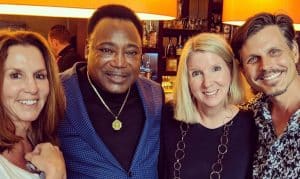
Dale nudges George awake, embraces him, and says goodbye. Our booty-shake decelerates to a shuffle and we exit the club, stage left. We’ve seen three sides of George tonight: the caring, consummate artist, the educator, and the indomitable celebrity determined to stay in the public eye. I don’t envy his balancing act. Limelight is an unflattering color for most of us. But it suits Mr. Benson.
Two in the morning. I haven’t been out this late since my New York days. I’ve grown soft around the middle, and the hard-lipped edge of the clammy July night rubs me where it hurts.
We return to Cologne the next day. George, made of smoke, mirrors, and a hefty dose of artistic drive and septuagenarian grit, recovers completely and—lifted by the loyalty of his adoring fans and his passion for music—performs his next concert within a week.
*****
Dale Cinski’s music is available on all streaming platforms. Check out his tribute to George tribute here:
Robin Meloy Goldsby is a Steinway Artist. She is the author of Piano Girl; Waltz of the Asparagus People: The Further Adventures of Piano Girl; and Rhythm: A Novel.
Newest book: Manhattan Road Trip, a collection of short stories about musicians. Go here to buy Manhattan Road Trip!
New piano album: Home and Away, Goldsby’s latest solo piano album, directly from the artist, at Amazon, or from your favorite streaming channels.
Sign up here to receive Robin’s free newsletter. A new essay every month!

